|
|
 |
COMBINATION SAWS
By Bob Garay
|
 |
As a tool collector I am always fascinated by the
ingenious combination tools thought up by inventors wanting to make a better mousetrap. In many cases these tools were overly
complicated to easily use and were tossed by the wayside for the more practical singular use tool. Today the impractical tool
that never caught on becomes a rare collectible. The hammer that is also a plane, the square that is also a rabbet plane,
or the ruler that is also a level. Being a saw collector I am always on the lookout for combination saws. The holy grail of
combo saws is the Disston No.43 saw. It is a beauty of a saw with a 26 inch straight back blade that has a incremented ruler
etched into the top edge. The specially shaped handle forms a 90 degree square with the saw blade and has a brass bar riveted
into the blade to keep this critical angle true. The handle has a double level set at 90 degrees to each other so the saw
can be used to plumb vertically or level horizontally. The levels are set in a beautifully cast brass fixture with floral
decorations boldly displaying “DISSTON” and the 1858 patent date. The applewood handle is exquisitely shaped with
a hole in the top to house a long steel scratch awl for layout work.
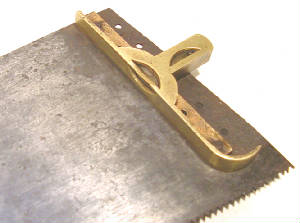
|
| Gorham patent showing brass square riveted to blade. |

|
| DISSTON #42 COMBINATION SAW |
This saw originated with a patent by Jackson Gorham issued on May 13, 1856 for a square and rule combination saw. Hiram Smith of Camden,
New Jersey added onto this design when he patented on May 18, 1858 improvements
on the Jackson Gorham patent. His design included brass shoulder strips riveted directly to the blade instead of the handle
to ensure squareness and provided a scratch awl
located in the handle for layout. It was utilized by the Disston Company when Henry Disston along with Thomas L Morss
patented the double level arrangement in May 25, 1858. These saws were sold until 1918 when Disston dropped them from their
product line.
Others copied the combination
of saw-square-ruler design but none came close to the beauty of the Disston No.43 saw. Disston manufactured a line of combination saws over the years with various numbering denotations. Below is the offerings
from Disston's 1911 catalog.
IMPROVED COMBINATION SAWS
THE MOST COMPLETE AND USEFUL SAWS EVER OFFERED TO THE TRADE
No. 43. Combination Saw, with 24-inch Square and Rule, Straight-edge and Scratch Awl;
Apple Handle, with Plumb and Level attachment. Blade same quality as Disston, No. 7 Hand-Saw.
26 inches, $30.00 per dozen.
No. 42. Combination Saw, with 24-inch Square and Rule, Straight-edge and Scratch Awl;
Apple Handle. Blade same quality as Disston, No. 7 Hand-Saw. Without Plumb and Level attachment. 26 inches, $25.00
per dozen.
No. 38. Combination Saw, with 24-inch Square and Rule, Straight-edge and Scratch Awl; Apple Handle. Blade same
as "Brown's," No. 3. 26 inches, $17.00 per dozen.
No. 39. Combination Saw, with 24-inch Square and Rule, Straight-edge and Scratch Awl;
Apple Handle, with Plumb and Level attachment. Blade same quality as "Brown's," No. 3. 26 inches, $22.00 per dozen.
No.
29. Combination Saw, with 24-inch Square and Rule, Straight-edge
and Scratch Awl. Beech Handle. 26 inches, $12.00 per dozen.
Over the years Disston offered many different varieties
of combination saws. In Erwin L. Schaffer’s book “HAND-SAW MAKERS OF NORTH AMERICA”, he lists over a dozen different Disston models as combination saws. Below are some of the offerings.
1856 - 1918
No.38 - Gorham sq. & rule
No.39
- Gorham plumb & level
No.42
- Gorham sq. & rule
No.43 - Gorham plumb & level
1858 -1860
No.25 - Gorham plumb & level
No.28 - plumb & level
No.29 - Gorham sq. & rule
1860 - 1 year
No.37 - Gorham plumb & level
1875 - 1 year
No.8 - Keystone plumb & level
No.9 - Keystone teeth sq. & rule
1880 - 1 year
No.77 - square & crosscut
1904 - 1 year
No.086 - Defiance sq. & rule
1914 - 1918
No.087 - Enterprise sq. & rule

|
| Disston combination saw with No. 24 stamp |
Of course Disston was not the only manufacturer of
combination saws. The company of Harvey Peace offered their COMBINATION SAW NO.1, a 26” saw with a square, rule, and
straight edge. They also offered an IMPROVED COMBINATION SAW No.29, comprising all the components of their No.1 saw with the
addition of a scratch awl. Woodrough & McParlin is well known for their No.12 carved panther-head handle. Their No.33
“On The Square” combination saw offered a 24” rule, straight-edge, and square. Wheeler, Madden & Clemson
Mfg. Co. offered their “Hard To Beat” combination saw with a 24”
square and rule, straight edge and scratch awl. I have another of their saws with a protractor on the blade to help draw angles.
Richardson Bros. also offered a No.1 & No.2 combination saw. The differences between the two is the No.1 had a rule on
both sides and a scratch awl with a fancier handle.
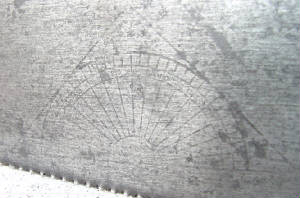
|
| Protractor etch on Geometric saw |
During more recent times manufacturers have revitalized
the combination saw. I have a “GEOMETRIC” combination saw made by the Geometric Saw Co. from the 1950’s. It has plumb
& level vials imbedded in the bakelite handle. It also has a 24” rule and square and a bevel gauge with different
angles marked off at the top horn.
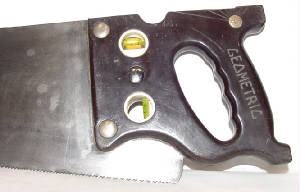
|
| Geometric combination saw |
Also from the 1950’s is a combination saw patented
to Harry M. McConnell from Harpster, Idaho Feb. 17, 1953. Manufactured by the Joy Tool Co. of Cornelius, Oregon, the No.100A
combination saw has plumb & level vials imbedded in the heavy plastic handle, and a 24” rule and straight edge at
the top edge of the blade.
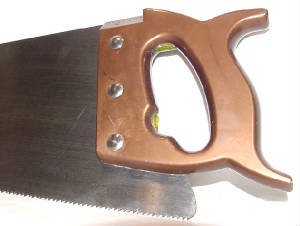
|
| 1950's Joy Tool Co. produced this combination saw. |
In 1949 another saw manufactured in
Kingsland Gaorgia, was called the “7 IN 1” combination saw. The Kingsland Saw Works was established and seems
to have continued operations for 6 or 7 years, up until 1956. The only product that they offered, is the Ulmos Hand Saw with
a cast miter gauge - square attached to both sides of the blade directly in front of the handle. The miter gauge has steps
cast into it for accurately laying out 90, 23 1/2, 32 and 45 degree angles. While the handle may look awfully funny and appear
homemade or missing the top horn, it is, in fact, complete and is original to the saw. All of the Ulmos Saws observed to date,
have the same style handle, the top horn is not missing and in fact the handle has a little thumb rest on the top edge. Besides
the miter gauges on the back side of the blade is etched a compass multi-angle gauge. It also has a rule at the top and a
small scribe cast at the top of the gauges.

|
| The Ulmos 7 in 1 combination saw |
Another combination saw is the “MITREWRIGHT
SAW” patented in 1906 by H.G. Osborne. It is a 12” back saw with an angled back that assists when marking 45 and
90 degree angles.
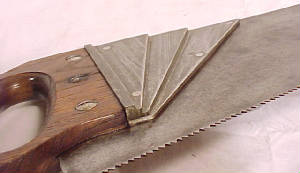
|
| The Ulmos saw with angle guides. |
Of course I have not found all of the
different combination saws yet. The search is never ending. That is what makes collecting tools so much fun. Just when you
think you have it all along comes something you have not seen before. Below are two patents of combination saws I have not seen produced. I am sure there are
more in our members collections so take a picture and email them to our editor. And if by chance you don’t mind parting
with it, I would love to add it to my collection.

|
| 1906 patented Mitrewright saw. |
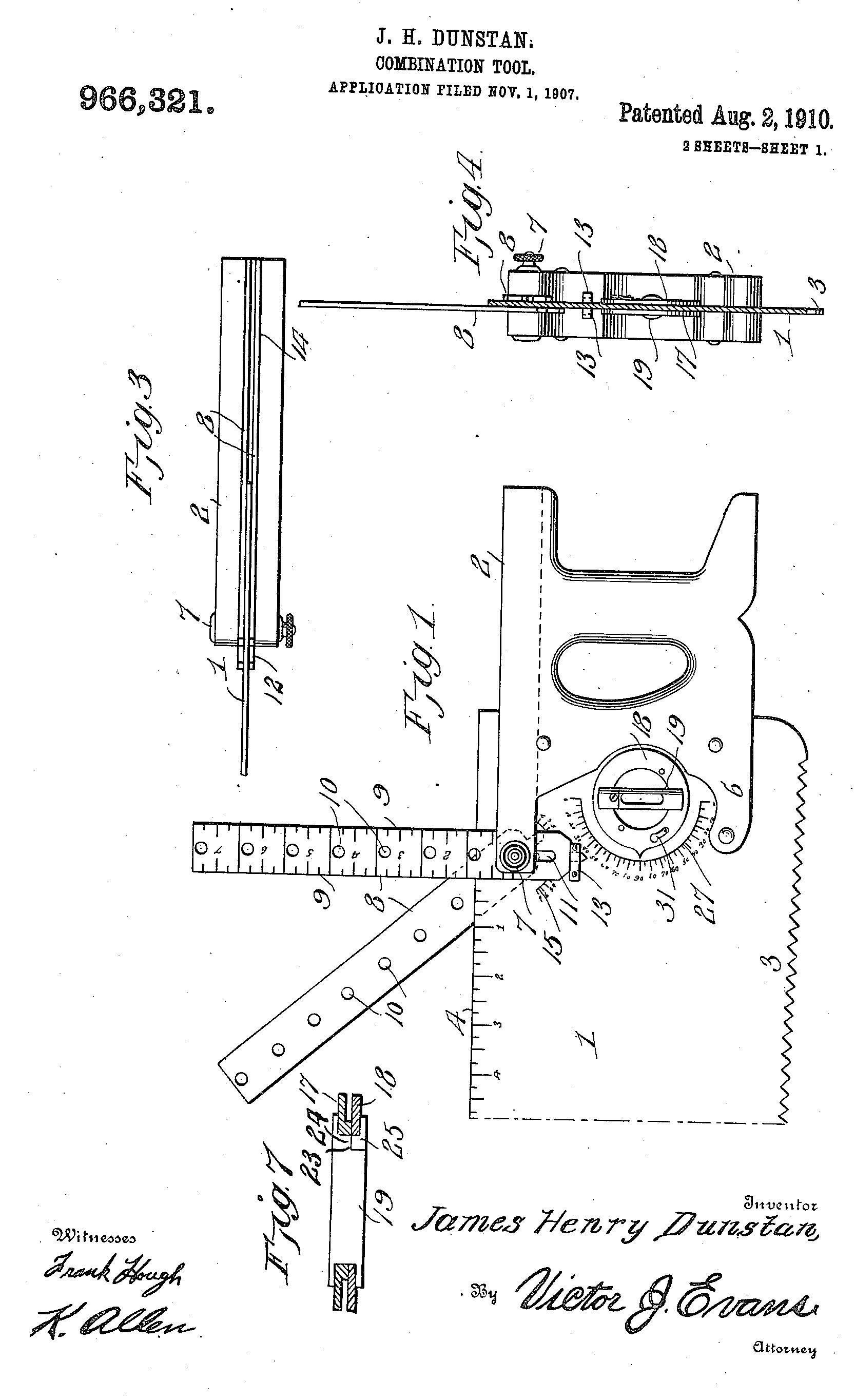
|
 |
|
|
 |
|
|
 |
|
|
 |
 |
Enter supporting content here
Takeadip Tools
|
|
|
|



